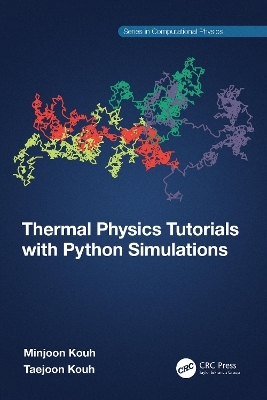
Thermal Physics Tutorials with Python Simulations
Seiten
2024
CRC Press (Verlag)
978-1-032-26343-4 (ISBN)
CRC Press (Verlag)
978-1-032-26343-4 (ISBN)
- Lieferbar (Termin unbekannt)
- Versandkostenfrei
- Auch auf Rechnung
- Artikel merken
This book provides an accessible introduction to thermal physics with computational approaches that complement the traditional mathematical treatments of classical thermodynamics and statistical mechanics. It guides readers through visualizations and simulations in the Python programming language, helping them to develop their own technical computing skills (including numerical and symbolic calculations, optimizations, recursive operations, and visualizations). Python is a highly readable and practical programming language, making this book appropriate for students without extensive programming experience.
This book may serve as a thermal physics textbook for a semester-long undergraduate thermal physics course or may be used as a tutorial on scientific computing with focused examples from thermal physics. This book will also appeal to engineering students studying intermediate-level thermodynamics as well as computer science students looking to understand how to apply their computer programming skills to science.
Key features
Major concepts in thermal physics are introduced cohesively through computational and mathematical treatments.
Computational examples in Python programming language guide students on how to simulate and visualize thermodynamic principles and processes for themselves.
This book may serve as a thermal physics textbook for a semester-long undergraduate thermal physics course or may be used as a tutorial on scientific computing with focused examples from thermal physics. This book will also appeal to engineering students studying intermediate-level thermodynamics as well as computer science students looking to understand how to apply their computer programming skills to science.
Key features
Major concepts in thermal physics are introduced cohesively through computational and mathematical treatments.
Computational examples in Python programming language guide students on how to simulate and visualize thermodynamic principles and processes for themselves.
Taejoon Kouh is a Professor of Nano and Electronic Physics at Kookmin University, Republic of Korea. Minjoon Kouh is a Professor of Physics and Neuroscience at Drew University, USA.
Chapter 1. Calculating π. Chapter 2. Kinetic Theory of Gas. Chapter 3. Velocity Distribution. Chapter 4. Thermal Processes. Chapter 5. Premise of Statistical Mechanics. Chapter 6. Revisiting Ideal Gas. Chapter 7. Revisiting Thermal Processes. Chapter 8. Entropy, Temperature, Energy, and Other Potentials. Chapter 9. Two-State System. Chapter 10. Specific Heat. Chapter 11. Random and Guided Walks. Appendix. Epilogue.
| Erscheinungsdatum | 14.03.2023 |
|---|---|
| Reihe/Serie | Series in Computational Physics |
| Zusatzinfo | 64 Line drawings, black and white; 6 Halftones, black and white; 70 Illustrations, black and white |
| Verlagsort | London |
| Sprache | englisch |
| Maße | 156 x 234 mm |
| Gewicht | 453 g |
| Themenwelt | Naturwissenschaften ► Physik / Astronomie ► Thermodynamik |
| ISBN-10 | 1-032-26343-1 / 1032263431 |
| ISBN-13 | 978-1-032-26343-4 / 9781032263434 |
| Zustand | Neuware |
| Haben Sie eine Frage zum Produkt? |
Mehr entdecken
aus dem Bereich
aus dem Bereich
Hauptsätze, Prozesse, Wärmeübertragung
Buch | Softcover (2023)
De Gruyter Oldenbourg (Verlag)
CHF 62,90


